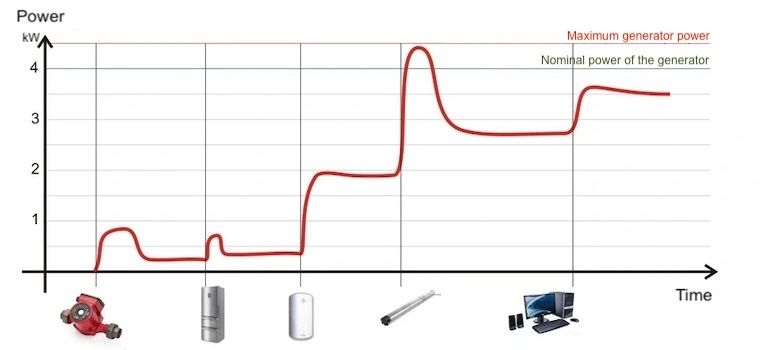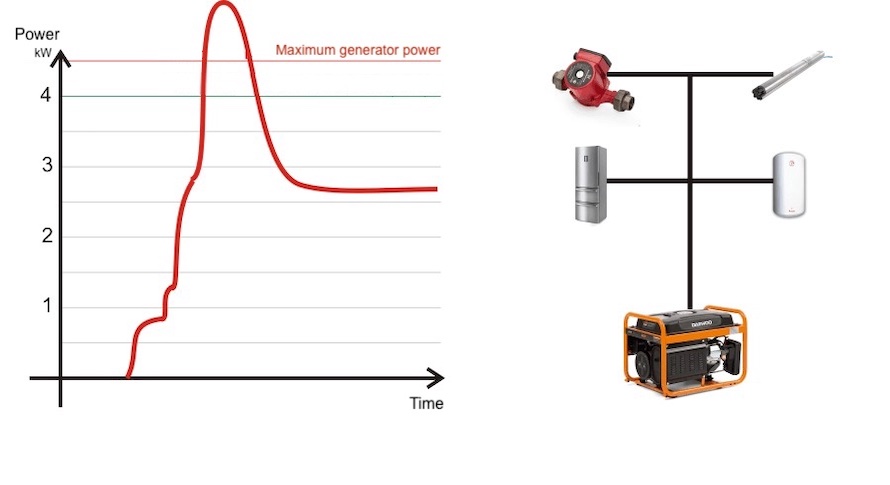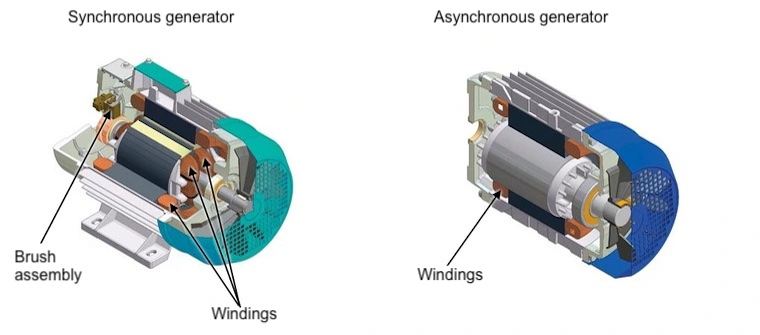Electricity has become so dense in our lives that we use it almost without noticing it. The degree of our dependence on electricity becomes noticeable only when it is not present. And then it turns out that it is still possible to live without electricity, but to live comfortably is no longer possible. In cities, power outages are rare and short-lived, so you won’t be able to feel all the delights of life in the pre-industrial era. But outside the city, sometimes you can’t do without an electric generator:
- For construction work in areas without electricity, purchasing a generator will be much more profitable than buying a battery tool kit.
- An electric generator will help with car repairs if there is no electricity in the garage.
- The electric generator will provide the usual level of comfort when leaving the nature or to the country house in a “deaf corner” without electricity.
- And finally, an electric generator can literally save the owner of a country house from freezing the heating system in winter during a long power outage. Yes, and in the summer it will not hurt – the pump in the well also works on electricity.
The latter argument is by far the most common reason for buying a power generator. It was the development of private housing construction that caused a real boom in the market for electric generators, which led to their abundance today. And this is not surprising: the needs of all buyers of generators are different: someone wants to power only the stove from the generator, someone wants to add another pump and refrigerator, someone needs a generator to turn on a powerful power tool. Generators in all these cases will require different ones, and attention should be paid not only to power, but also to other characteristics.
Characteristics of electric generators
The output power determines both the capabilities of the generator (how much it will “pull” electrical engineering), and its weight, and its price.
But how much power do you need? The consultant in the store, most likely, will advise you to sum up the power of all appliances used at home and will definitely remind you of the starting coefficient of reactive electricity consumers. The fact is that all electrical appliances are divided into two types – active and reactive consumers. For active consumers, all electricity is converted into heat – these are electric heaters, irons, incandescent lamps, electric kettles, etc. The power consumption of active consumers is constant. And reactive consumers part of the energy is spent on creating an electromagnetic field and at the moment of switching on they consume power for a short time, significantly exceeding the nominal one. Reactive consumers are electrical appliances containing motors, transformers, electromagnets, etc. – refrigerators, washing machines, vacuum cleaners, etc.
And if we take for example some private house with a 1.5 kW electric water heater, with a 750 W borehole pump, a 120 W refrigerator and two 100 W circulation pumps, then for these devices the required power will be 1500 + 750 * 7 +120*3+200*4=7910 W. Then the consultant will advise you to add a couple of kilowatts to the TV, computer and “what, you won’t even turn on the light?” and now the buyer is taking home a 10-kilowatt “monster”.
While of the listed electrical appliances, only circulation pumps operate continuously, consuming their 200 W, and a continuous load will be a maximum of 2-3 kW. The saying “the pocket does not pull the reserve” does not apply to electric generators – prolonged operation with a load not exceeding 30% of the nominal value is harmful for them – in this mode, soot builds up quickly on candles and in the exhaust tract.
Maximum power
Therefore, the optimal power selection method is to determine which of the reactive consumers has the maximum peak power, then add it to the power of constantly operating reactive loads. When determining the consumer with the maximum peak power, you should clarify its starting factor in the instruction manual (if it is there) – the value given in the table may differ greatly from the real one for a particular model.

So, in the above example, the maximum power consumed during start-up is a submersible pump with 750 * 7 \u003d 5250 W peak power. If we assume that this pump is Grundfos SP 1A-28. Then according to the manual, its starting current multiplier is not 7, but only 3.6. Thus, the peak power of the pump will be 750 * 3.6 = 2700 watts. The maximum possible active load at the moment the pump. Is turned on will be 1820 W (electric heater + refrigerator + two pumps). Adding 2700, we get 4520 watts.
Moreover, the obtained power value will be required only to start the pump, the constant load on the generator will be less. Therefore, we select a generator not with a nominal, but with a maximum output power corresponding to the received number. The maximum output power is the power that the generator is able to deliver for a short time without harm to itself. In this case, this is exactly what is needed.
Generator with a rated power
So a generator with a rated power of 4 kW. And a maximum of 4.5 kW is quite suitable for the given example. And will cost 5-10 times cheaper than the previously “selected” 10-kilowatt one.
The only feature that should be taken into account with this method of selecting the power of the generator is that consumers should be connected to it gradually. In no case should you connect the generator to the power supply of the house with the electrical appliances turned on. So that they receive power at the same time. This can lead to the failure of the generator, especially if it does not have overload protection.

Generator type
Asynchronous generator
The asynchronous generator has the simplest design. Its rotor does not contain windings (only permanent magnets), there is no brush assembly. Such a generator is easier to maintain, cheaper, lighter, less susceptible to dust and moisture. Another important advantage of an asynchronous generator is that it is not afraid of high currents. Up to a short circuit. This allows you to use the generator to connect welding machines.
The main disadvantage of an asynchronous generator is that the parameters of the voltage it generates depend on the load. Therefore, asynchronous generators are not recommended to be used to supply electricity to consumers demanding on its quality (frequency and voltage stability, sinusoidal signal shape). Gas boilers, refrigerators, UPS, circulation and borehole pumps. But immunity to high currents allows you to connect a powerful construction tool to an asynchronous generator. Often working with overloads.

Synchronous generator
The synchronous generator has an excitation winding on the rotor, powered through a brush assembly. The frequency of the alternating voltage at the output of the synchronous generator depends only on the rotor speed. And remains constant when the load changes. This allows you to use a synchronous generator to connect household appliances. That are demanding on the quality of the power supply.
The disadvantage of a synchronous generator is that in order to maintain the frequency of the voltage. The motor must rotate at a constant speed, regardless of the power taken from the generator. This greatly reduces the efficiency of the generator when the load drops. For stable productive work, the synchronous generator must be constantly loaded at 50-80% of the nominal value.
Inverter generator
An inverter generator can be based on both an asynchronous and a synchronous generator. But unlike “pure” synchronous and asynchronous ones, in an inverter generator. The output voltage is first rectified, then converted to AC using an electronic circuit – an inverter.
This makes it possible to achieve high stability of the frequency. And voltage of the power supply without maintaining a constant engine speed. Inverter generators allow operation with a low load (their consumption will be much less than that of synchronous ones). However, at rated load, the efficiency of inverter generators is lower than that of synchronous ones.
You can often hear the statement that only inverter generators are able to provide an ideal output waveform under any operating conditions. And that is why the gas boiler can only be powered by an inverter generator. This is not always true – yes. An inverter generator is better than any other withstanding frequency and voltage with load changes.
But the signal shape (sinusoid) on inexpensive inverter converters is initially far from ideal. In order to reduce the price, the manufacturer does not install a smoothing filter at the output of the generator. And a “ladder” goes to the consumer instead of a sinusoid.

The harm of such a signal is ambiguous. Most household appliances will “not notice” the difference. But some electronic devices (measuring instruments, gas boilers, audio and video equipment) may start to fail or refuse to work at all.
A good inverter generator that provides a “pure” sine wave output voltage will cost much more than a synchronous one.
Generators
So the boiler can be powered not only from an inverter generator. A synchronous generator is more likely to give a “clean” sine wave than a cheap inverter one. In general, most of the problems when connecting the boiler to the generator arise not because of the waveform. But because of the ungrounded neutral of the generator. Leading to the absence of a “neutral” power wire. For the correct operation of the flame control circuits of gas boilers. There must be a 220V phase on one power wire, and 0 on the other. ).
Voltage stabilization
Voltage stabilization is used to maintain power supply parameters when the load changes.
Most modern synchronous generators are equipped with AVR – automatic voltage regulator. The AVR electronic circuit controls the output voltage. When it changes, increases or decreases the current of the field winding. This allows you to maintain the output voltage within 220 + 5% at any load.
Asynchronous generators are stabilized with shunt and compound capacitors to help maintain voltage during short-term voltage drops. But such a stabilizer cannot cope with strong and prolonged drops.
Inverter generators do not need a voltage stabilizer – it will be stable anyway under any load.
Voltage
Generators can be either single-phase – for connecting household appliances at 220V (230V). Three-phase – for connecting more powerful equipment at 380V (400V). A single-phase electrical appliance can be connected to a three-phase generator (as a rule, it has separate 220V sockets). On the contrary, it is impossible. Three-phase generators provide more options, but also cost more.
Many generators also have an additional 12V DC output – these models can be used to recharge a car battery.
Engine cycle
Two-stroke engines are lighter and cheaper than four-stroke ones. But most of them require fuel blending (adding a certain amount of oil to the fuel) to refuel. In addition, two-stroke engines have a significantly lower motor resource – 500-700 hours.
For a backup generator that runs several times a year. This is not critical, but if the generator is purchased for permanent operation. It is better to choose among four-stroke ones. In addition to an order of magnitude greater motor resource, four-stroke engines are economical and less noisy.
Launch
Most generators – equipped with a rope starter to manually start the engine. The presence of an electric starter (electric start) can greatly facilitate the operation of the generator. But keep in mind that the electric starter significantly increases the price and weight of the generator. If the generator purchased for occasional use. Then better to stop at a model with a manual start. After months of inactivity, the battery will most likely discharged, and you still have to start the generator manually.
Electric starting of emergency generators is really necessary only if the generator is supposed to be started in the event of a mains power failure. The installation of an ATS (automatic starter of the reserve) will allow such generators to start automatically. Some generators – already equipped with automatic start.
Type of fuel
For most tasks, gasoline generators are preferable due to their low price and low weight. But if it is planned to run the generator often and for a long time. Then the price of fuel becomes an important criterion. In this case it makes sense to pay attention to hybrid gas-gasoline generators. Although they are more expensive than gasoline ones, this difference will quickly pay off due to lower gas prices.
Diesel engines are more economical than gasoline engines and have a longer resource. But they weigh much more, so diesel engines usually equipped with powerful generators designed for continuous operation in one place.
Generator Options
An inverter generator of low power will allow you not to feel cut off from civilization while traveling out of town. With its help you can organize lighting, recharge a laptop or car battery.
For emergency power supply of the most necessary electrical equipment, an inexpensive 2-4 kW synchronous generator will be enough. This is enough to “keep afloat” the heating and water supply of a private house during a power outage.
If you need a generator to power a power tool on sites without electricity, choose from 4-6 kW models . This is enough to start most types of hand-held power tools.
A generator with a capacity of 7-10 kW is able to fully provide electricity to a large private house.
Hybrid gas-gasoline generators can significantly reduce the price of a kilowatt-hour – with frequent use of the generator. This gives significant savings.

There are no comments yet.